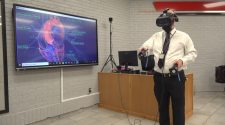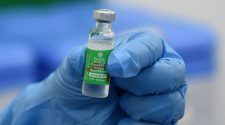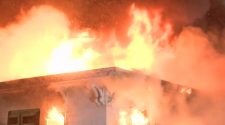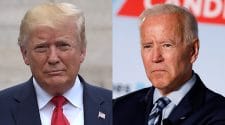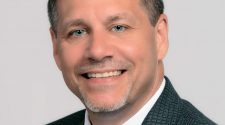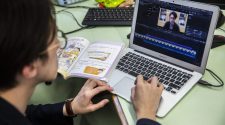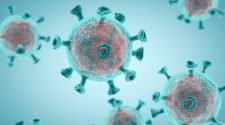with Paulina Firozi
Are you a medical provider who has become sick with covid-19? If so, we’d love to hear your story. Please send me a note.
Thanks for reading The Health 202, especially now. Sign up here and forward our daily health policy tipsheet to your friends, family and colleagues.
Los Angeles Mayor Eric Garcetti. (Office of Mayor Eric Garcetti/AP)
THE PROGNOSIS
Los Angeles authorities were among the first in the nation to issue a stay-at-home order to stem the spread of coronavirus.
Now, they’re trying to discover how many people have actually been infected, recovered and developed immunity to the virus. The answer to that question carries hefty ramifications for health officials – both at the state and national level – considering how to keep the public safe and restart economic activity.
This weekend, L.A. County’s public health department is planning to test 1,000 randomly selected residents using one of the antibody tests that are starting to become available around the country. These “serology” tests, which measure whether someone has already had the virus and thus developed antibodies against it, can give researchers a better idea of how broadly the virus has infected the American public, how deadly it is and what future demands medical facilities should prepare for.
“It’s going to provide vital information to help inform our response to this covid crisis,” Paul Simon, chief science officer for the L.A. County Department of Public Health, told me. “Currently, we have a very limited understanding of the degree of spread of the virus in our population.”
When L.A. Mayor Eric Garcetti (D) issued a lockdown order three weeks ago, he and other California leaders were ahead of most other mayors and governors around the country. And their swift action seems to have paid off; fewer than 200 people have died of the virus in L.A., compared with nearly 6,300 in New York City.
This is the next step: “We want to know how many people in L.A. County were ever infected with covid-19,” Neerja Sood, a vice dean at the University of Southern California involved in the project, told me. “That number is critical for figuring out how deadly this disease is or how contagious it is.”
The virus’s infection rate is a gaping data hole. That makes it doubly hard for government and public health officials to know how to proceed with social-distancing guidelines that have stemmed the spread of the deadly virus but also cost tens of millions of Americans their livelihoods. While around 430,000 people in the United States have tested positive for the virus, scientists believe many more have been infected and had either mild or no symptoms.

(Mike Blake/Reuters)
Sood and other professors from USC and Stanford University are working with L.A. County officials to conduct the testing at six sites, which will include the parking lots of clinics and libraries.
Sood said the test kits — which are from the Minneapolis-based company Premier Biotech — were donated to him by a private individual who read his March 15 Wall Street Journal op-ed arguing for the importance of conducting large-scale randomized testing. He received a supply of 5,000 kits, which the county plans to use for testing every two weeks.
The best-case scenario would be for the researchers to discover that a large share of L.A. residents have already been infected. So-called “herd” immunity could be good news for the economic shutdown, because it would mean many people could start returning to work.
Simon told me that he highly doubts the infection rate is as high as 40 or even 60 percent as some have suggested. “I would be shocked if that’s the case,” he said. But if it proves true, he said it could mean physical-distancing restrictions could start to be loosened and the world could start returning to normal. Many people would already have immunity to the virus, so it would be safe for them to return to normal activities.
Simon thinks it’s more likely that fewer than 10 percent of the county’s population has been infected. If it’s between 5 and 10 percent, that would suggest the rate of serious cases resulting in hospitalization or even death is not as bad as originally thought, he said.
If the infection rate is even lower, say about 2 percent, it would underscore a need to continue physical distancing because a large population is still at risk for becoming infected.
Data from other countries, while incomplete, suggests infection rates in the general population may be between one percent and 15 percent. Fifteen percent of Spanish residents may have been infected and developed immunity while the infection rate may be just 0.72 percent in the German population, according to a report by London’s Imperial College.
Former FDA commissioner Scott Gottlieb:
In U.S., experts suggest to me rate is lower. My informal survey of thought leaders in this area puts estimate anywhere from 1-5%. Ultimately we must confirm this with serology studies (which are underway). But it falls short of the 50-70% needed to achieve “herd” immunity 8/n
— Scott Gottlieb, MD (@ScottGottliebMD) April 8, 2020
There are signs the Trump administration is starting to recognize a need for more serological testing, although the leaders of the White House coronavirus task force have spent much of their time responding to frustration about the slowness of rolling out diagnostic testing.
Last month, the Food and Drug Administration announced that developers of antibody tests can use or market their tests without agency approval and it has also authorized one such test, from the company Cellex, for emergency use by clinical laboratories.
But while more than 70 companies have notified the FDA they have serology tests available for use, some are falsely claiming their tests have been approved, the agency said in a warning posted to its website on Tuesday.
“The FDA will take appropriate action against firms making false claims or marketing tests that are not accurate and reliable,” the agency wrote.
AHH, OOF and OUCH
AHH: Sen. Bernie Sanders (I-Vt.), the Medicare-for-all candidate, has ended his presidential bid. Former vice president Joe Biden now has a clear path to the Democratic nomination to take on Trump in the general election.
The departure, which marked the “close of a roller-coaster primary race that started more than a year ago,” our Post colleagues Sean Sullivan, Matt Viser and Dave Weigel report, follows Biden’s decisive wins in three states on March 17, after which the Sanders campaign said he would assess a path forward. Those were the last contests before the coronavirus pandemic effectively halted all traditional forms of campaigning.
“As I see the crisis gripping the nation,” Sanders told supporters in a video address from his home in Burlington, Vt., “I cannot in good conscience continue to mount a campaign that cannot win and which would interfere in the important work required of all of us in this difficult hour.”
Biden released a lengthy statement:
“He hasn’t just run a political campaign; he’s created a movement,” Biden said. “And make no mistake about it, I believe it’s a movement that is as powerful today as it was yesterday.”
But not everyone on Sanders’s side is ready to fall in line with supporting Biden.
“While you are now the presumptive Democratic nominee, it is clear that you were unable to win the votes of the vast majority of voters under 45 years old during the primary,” said an open letter to Biden signed by eight liberal groups urging the former vice president to adopt their ideas on climate change, health care and other topics. “Messaging around a ‘return to normalcy’ does not and has not earned the support and trust of voters from our generation.”
— Sanders’s Democratic socialist platform dominated much of the national conversation for the past year. Many of his talking points seemed to resonate amid the coronavirus crisis, HuffPost’s Tara Golshan writes.
“Suddenly, Democrats and Republicans were backing expansions to unemployment benefits and paid leave, and making coronavirus testing cost-free,” Tara writes. “… Some politicians seemed to discover the benefits of a strong social safety net and aggressive government action only as the country scrambled to deal with the coronavirus outbreak and saw the economy shut down. Sanders has been decrying the immorality of the gaps in the American safety net for a lifetime.”
Trump had this to say:
Bernie Sanders is OUT! Thank you to Elizabeth Warren. If not for her, Bernie would have won almost every state on Super Tuesday! This ended just like the Democrats & the DNC wanted, same as the Crooked Hillary fiasco. The Bernie people should come to the Republican Party, TRADE!
— Donald J. Trump (@realDonaldTrump) April 8, 2020

Medical workers wearing personal protective equipment wheel bodies to a refrigerated trailer serving as a makeshift morgue at Wyckoff Heights Medical Center, in the Brooklyn borough of New York. (John Minchillo/AP)
OOF: At least 759 people under 50 have died of covid-19 across the United States, according to a Post analysis of state data.
The virus is still most threatening to the elderly and compromised, yet the data show no one is immune, our Post colleagues Chris Mooney, Brady Dennis and Sarah Kaplan report.
“For the very young — people under the age of 20 — death is extremely rare in the current pandemic. But it happens: The Post identified nine such cases,” they write. “The risk appears to rise with every decade of age. The Post found at least 45 deaths among people in their 20s, at least 190 deaths among people in their 30s, and at least 413 among people in their 40s.”
And the data are incomplete, suggesting the number of deaths among young people could be higher. Numerous states don’t provide information on deaths by age group.
— The Centers for Disease Control and Prevention released data yesterday showing that out of 1,400 hospitalizations, just over 25 percent of coronavirus-related hospitalizations were of people under age 50. Most of these young people had underlying conditions, though our colleagues note at least seven had no other health problems, highlighting the small fraction of severe covid-19 cases that remain difficult to explain.
New York, which has had the largest outbreak in the United States, also has the largest number of deaths among younger people: As of yesterday, the deaths included six New York residents under 20, 33 people in their 20s, 118 in their 30s and 265 in their 40s.
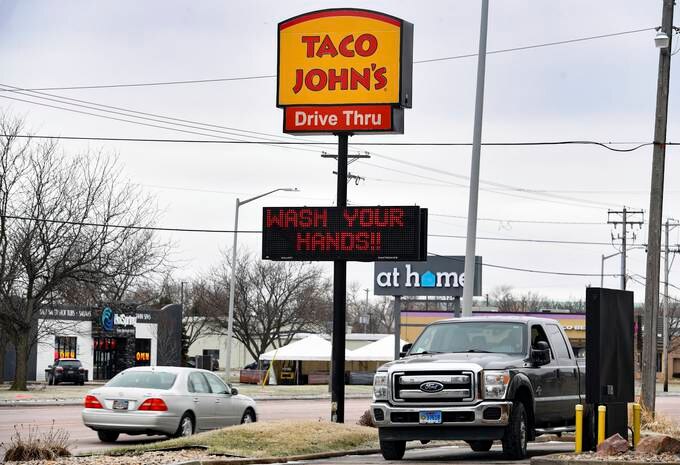
A Taco John’s marquee reminds people to practice good hygiene in Sioux Falls, S.D. (Erin Bormett/Argus Leader/AP)
OUCH: More than two-thirds of the rural counties in the United States now have coronavirus cases. One in 10 of the counties have reported at least one death, the New York Times’s Jack Healy, Sabrina Tavernise, Robert Gebeloff and Weiyi Cai report.
The spread of the virus to rural regions is particularly troublesome because their communities include older, poorer and sicker populations. Doctors and officials worry the spread could overwhelm the areas that already have limited medical resources.
“Everybody never really thought it would get to us,” 18-year-old Grace Rhodes, who is studying to be a nurse, told the Times. “A lot of people are in denial.”
“With 42 states now urging people to stay at home, the last holdouts are the Republican governors of North Dakota, South Dakota, Nebraska, Iowa and Arkansas,” the NYT piece says.
“Rural nurses and doctors, scarce in normal times, are already calling out sick and being quarantined,” they write. “Clinics are scrambling to find couriers who can speed their coronavirus tests to labs hundreds of miles away. The loss of 120 rural hospitals over the past decade has left many towns defenseless, and more hospitals are closing even as the pandemic spreads.”
“We’re behind the curve in rural America,” said Sen. Jon Tester (D-Mont.).
TRUMP TEMPERATURE
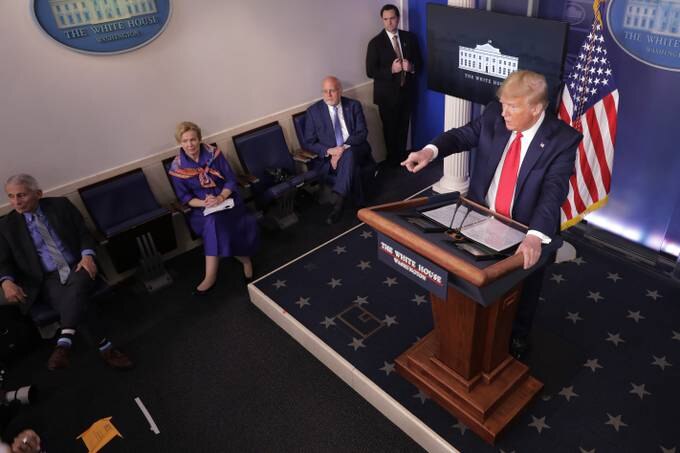
President Trump calls on reporters during a news conference. (Chip Somodevilla/Getty Images)
— Trump is preparing to unveil a second, smaller coronavirus task force. He’ll make the announcement as soon as this week, our Post colleagues Ashley Parker, Josh Dawsey and Yasmeen Abutaleb report.
“The task force will be made up of a mix of private-sector and top administration officials, including chief of staff Mark Meadows — whose first official day on the job was last week — Treasury Secretary Steven Mnuchin and national economic adviser Larry Kudlow, a senior administration official said,” they write.
This additional task force will focus on how to reopen the nation and will determine what businesses will need to rebound. “The goal is to get as much of the country as possible open by April 30, the current deadline Trump set for stringent social-distancing measures,” our colleagues add. “The economic task force will not meet every day, like the large one, and is expected to have a more informal feel, with many of the meetings held over the phone and as in-person briefings with the president.”

WHO Director-General Tedros Adhanom Ghebreyesus. REUTERS/Denis Balibouse/File Photo
— A number of world leaders, along with President Trump, say the World Health Organzation has been too trusting of the Chinese government, which initially tried to hide and then downplay the coronavirus outbreak in Wuhan, the New York Times’s Javier C. Hernandez reports.
“In Japan, Taro Aso, the deputy prime minister and finance minister, recently noted that some people have started referring to the World Health Organization as the ‘Chinese Health Organization’ because of what he described as its close ties to Beijing,” Javier writes. “Taiwanese officials say the W.H.O. ignored its early warnings about the virus because China refuses to allow Taiwan, a self-governing island it claims as its territory, to become a member.”
As the virus was spreading in December and January, Chinese health officials repeatedly played down the severity of the outbreak, even claiming there was no evidence it could be transmitted among humans on a large scale.
“The W.H.O. endorsed the government’s claims, saying in mid-January, for example, that human-to-human transmission had not been proven,” Javier writes. “Critics say the organization’s repeated deference to Beijing exacerbated the spread of the disease. A group of international experts was not allowed to visit Wuhan until mid-February.”
Trump tweeted this on Tuesday:
The W.H.O. really blew it. For some reason, funded largely by the United States, yet very China centric. We will be giving that a good look. Fortunately I rejected their advice on keeping our borders open to China early on. Why did they give us such a faulty recommendation?
— Donald J. Trump (@realDonaldTrump) April 7, 2020
— W.H.O. Director General Tedros Adhanom Ghebreyesus has pushed back, warning against “politicizing” the pandemic.
“Please do not politicize this virus,” Tedros said. “If you want to be exploited and if you want to have many more body bags, then you do it. If you don’t want many more body bags, then you refrain from politicizing it.”
Bloomberg News:
Wet markets are returning to life in Wuhan and other parts of China, where the #coronavirus first emerged.
More @business: https://t.co/e59s5mwooe #COVIDー19 #CoronavirusPandemic pic.twitter.com/IOqNqfchbK
— QuickTake by Bloomberg (@QuickTake) April 9, 2020
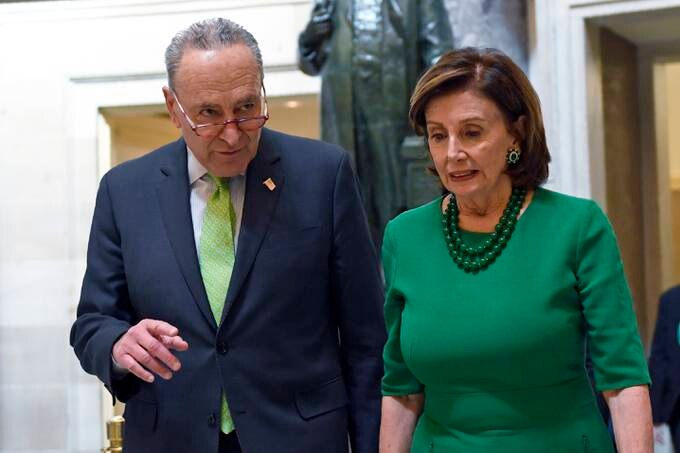
Senate Minority Leader Charles E. Schumer (D-N.Y.) and House Speaker Nancy Pelosi (D-Calif.) said the $250 billion package involving small-business relief should be followed by another major rescue bill. (Susan Walsh/AP)
— There’s a showdown between the Trump administration and Democrats over more relief.
The administration is seeking $250 billion in new funding for small businesses, but House Speaker Nancy Pelosi (D-Calif.) and Senate Minority Leader Charles E. Schumer (D-N.Y.) say any coronavirus package including that funding must also send $250 billion in additional funds for hospitals, state and local governments and food stamp recipients, The Post’s Erica Werner, Mike DeBonis and Seung Min Kim report.
“As of late Wednesday, Senate Republicans and Democrats planned to bring competing measures to the floor on Thursday, virtually ensuring that neither measure would pass,” they wrote. “… The White House wanted the Senate to vote on the measure Thursday and the House to pass it by Friday, but as of late Wednesday it was unclear how Congress would proceed.”
“I have said very clearly: What they are proposing will not get unanimous consent in the House. There is no reason why they cannot come to the table and see the value of what we are offering,” Pelosi told our colleague Robert Costa about the Democrats’ counter to Treasury Secretary Steven Mnuchin. “You cannot expect us to ossify inequality in access to capital as we try to fight the coronavirus.”
Today, Senate Majority Leader Mitch McConnell (R-Ky.) plans to bring the $250 billion small-business increase up on the floor without Democrats’ priorities included, essentially daring Democrats to object. “An objection from any individual senator would block passage of the legislation. Democrats plan to block McConnell’s bill and propose one of their own on Thursday, which will probably result in an impasse,” our colleagues explain.
Tomorrow morning, I’ll ask unanimous consent to pass standalone emergency funding for the hugely popular Paycheck Protection Program that is saving small-business jobs as we speak. As the rest of the CARES Act continues to come online, this key part is already low on funds.
— Leader McConnell (@senatemajldr) April 9, 2020
Coronavirus latest
— Other headlines and developments to catch up on this morning:
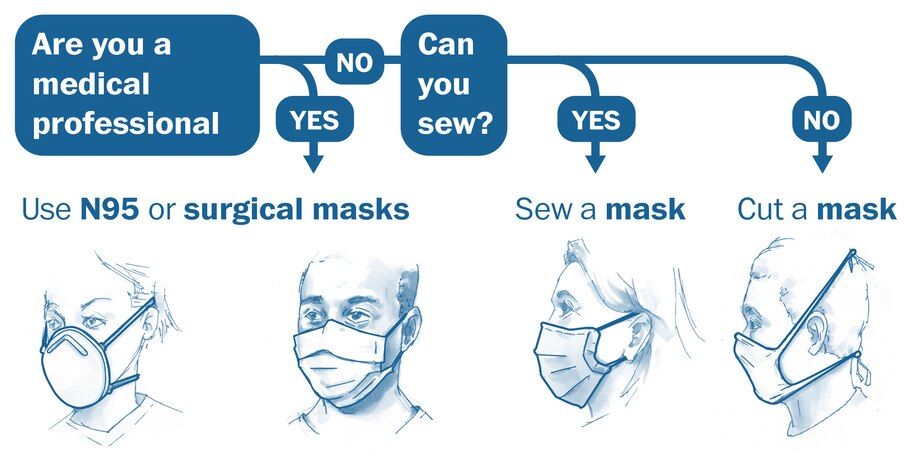
Good to know:
- The coronavirus is extremely tiny and is too small to be trapped by most fabrics. So if you embark on making a DIY cloth mask at home, as U.S. health officials now recommend, our Post colleagues Bonnie Berkowitz and Aaron Steckelberg have a helpful graphic explaining what fabrics are best to use (cotton seems to be a good choice) and why homemade masks can be help wearers prevent unknowingly spreading the virus to others.
- Experts say it’s not enough for social distancing to show signs of “flattening the curve.” “Instead, aggressive mitigation measures, such as social distancing and the closure of nonessential businesses, should continue, even when the trend is moving in the right direction,” our Post colleague Joel Achenbach reports.
The economic fallout:
- Nearly a third of apartment renters in the United States did not pay their April rent in the first week of the month, according to the National Multifamily Housing Council and a consortium of real estate data providers, highlighting the strain on Americans trying to pay rent amid the pandemic, the Wall Street Journal’s Will Parker reports.
On the front lines:
- The District has purchased two top-of-the-line decontamination machines to clean ambulances. They were put into service on March 21 and have been used 400 times since, our Post colleague Julie Zauzmer reports.
- Some critical-care physicians are challenging the extensive use of ventilators for coronavirus patients and say some patients may be treated with less intensive respiratory support equipment, Stat News’s Sharon Begley reports.
- In New York, 89,456 medical workers volunteered to help the state address the coronavirus outbreak and relieve exhausted front-line health providers. But only 7,000 have been assigned to a job, our Post colleague Kent Babb reports.
A defining moment:
- For Generation Z, which was already political liberal, the current crisis “may solidify their political identity, experts say,” our Post colleague Hannah Knowles reports. “As the pandemic and its economic havoc exacerbate disparities, some Gen Zers see grim validation of their support for the government-run programs and social-welfare policies less popular with their parents and grandparents.”

